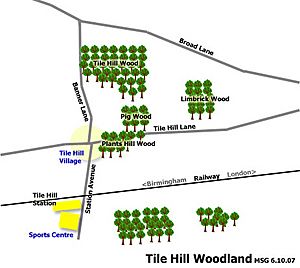Tile Hill Wood facts for kids
Tile Hill Wood is a special forest located between Hawthorn Lane and Banner Lane in the Tile Hill area of Coventry, England. It's a beautiful place where different kinds of trees grow together. This wood is so important that it has two special titles: a Site of Special Scientific Interest and a Local Nature Reserve. This means it's protected because of its unique plants and animals. A group called the Coventry and District Natural History and Scientific Society helps take care of it.
Contents
Exploring Tile Hill Wood: A Special Forest
Tile Hill Wood covers about 70 acres. That's like 50 football fields! It has a mix of trees, including both those that lose their leaves in autumn (called deciduous) and those that stay green all year (called coniferous). You can find tall Norway Spruce and elegant European Larch. There are also bushy Hazel coppice trees. Other common trees here are Sycamore, Oak, Birch, Chestnut, Ash, and Pine.
The wood has special paths, about 660 meters long. These paths are great for everyone, including people with disabilities. They even have metal rails that help people who can't see well find their way around safely.
A Look Back: How Tile Hill Wood Grew
In 1930, the city of Coventry decided to make Tile Hill Wood a protected Nature Reserve. They even had a special forester who regularly looked after the wood. This person made sure paths were clear. They also removed waste using a horse and cart, not big machines.
During the Second World War, large areas of bushes and evergreen trees were cleared. This was done to lower the risk of fires from air-raids. In March 1947, a very strong storm called a cyclonic gale hit the area. Five acres of mature spruce trees were pulled up by their roots. Young trees were planted over several years to replace them. This helped change the types of plants and animals living in the reserve.
Why is Tile Hill Wood So Important?
Tile Hill Wood received its special SSSI status in 1952. This status was renewed in 1986 under a law called the Wildlife and Countryside Act of 1981. The wood is a great example of a semi-natural woodland. It is one of the last remaining natural forests in the county.
The ground of the wood is covered with plants like bramble and bracken. You can also find wavy hair-grass and creeping soft-grass. Beautiful plants like honeysuckle and great wood-rush grow here too.
Amazing Plants and Fungi
Typical woodland plants that you might see include wood-sorrel, primrose, and bluebells. In the wetter parts of the wood, you can find woodmillet and remote sedge.
Near the north edge, there are pools that support special plants. These include bog mosses, marsh cinquefoil, and cyperus sedge. There's also a small wet area called a mire. This mire is full of different mosses. It also has clumps of bottle sedge and white sedge.
Even rare fungi can be found here! An uncommon fungus called Clavaria rosea was recorded in Tile Hill Wood. It was the first time it had ever been seen in the county.


